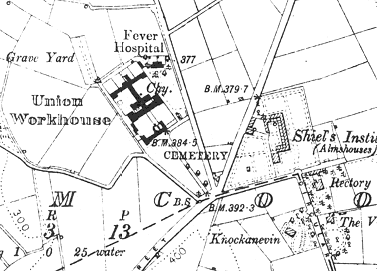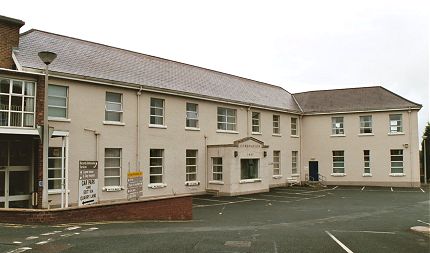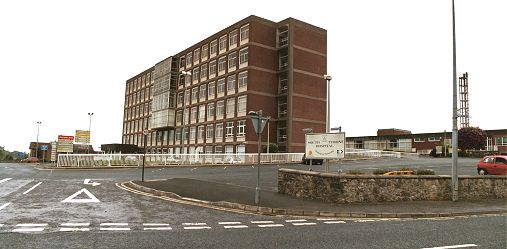Dungannon, Co. Tyrone
Dungannon Poor Law Union was formally declared on the 20th July 1839 and covered an area of 160 square miles. Its operation was overseen by an elected Board of Guardians, 26 in number, representing its 19 electoral divisions as listed below (figures in brackets indicate numbers of Guardians if more than one):
Co. Tyrone: Aghnahoe, Altmore, Ballymagran, Benburb (2), Bernagh, Brantry, Castle Caulfield (2), Clonaneese, Clonavaddy, Crossdernot, Derrygortrery, Drumaspil (2), Dunnaghmore (2), Dungannon (2), Meenagh, Minterburra, Mountjoy, Moy (2), Tullniskan (2).
The Board also included 8 ex-officio Guardians, making a total of 34. The Guardians met each week on Thursday.
The population falling within the Union at the 1831 census had been 66,075 with divisions ranging in size from Altmore (population 2,226) to Dunnaghmore (5,439).
The new Dungannon Union workhouse was erected on a six-acre site to the north of Dungannon. Designed by the Poor Law Commissioners' architect George Wilkinson, the building was based on one of his standard plans to accommodate 800 inmates. Its construction cost £6,650 plus £1,350 for fittings etc. The workhouse was declared fit for the reception of paupers on 16th May 1842 and admitted its first inmates on 23rd June.
The workhouse location and layout are shown on the 1910 OS map below.

Dungannon workhouse site, 1910.
The buildings followed Wilkinson's typical layout. An entrance and administrative block at the south contained a porter's room and waiting room at the centre with the Guardians' board room on the first floor above. It was later extended at the west with the addition of children's accommodation and school rooms.
The main accommodation block had the Master's quarters at the centre, with male and female wings to each side. At the rear, a range of single-storey utility rooms such as bakehouse and washhouse connected through to the infirmary and idiots' wards via a central spine containing the chapel and dining-hall.
During the famine in 1846, a 40-bed fever hospital was erected at the north of the workhouse. A house was also hired to accommodate an additional 200 inmates.

Dungannon fever hospital from the south-west, 2003.
© Peter Higginbotham.
At the 1901 census, the population of the Union was 32,563.
The site later became the home of the South Tyrone hospital. The last remaining block of the main workhouse was demolished in 1978, although part of the much altered fever hospital survives in what is now Coronation ward.

Dungannon former workhouse site from the east, 2003.
© Peter Higginbotham.
Records
Note: many repositories impose a closure period of up to 100 years for records identifying individuals. Before travelling a long distance, always check that the records you want to consult will be available.
- Public Record Office of Northern Ireland, 2 Titanic Boulevard, Titanic Quarter, Belfast BT3 9HQ. The modest holdings include Board of Guardians' minutes (1899-1944) and Master's Journals (1934-36).
Bibliography
- The Workhouses of Ulster by Michael H Gould (1983, Ulster Architectural Heritage Society).
- Workhouses of the North West Edited by Jack Johnston (1996, WEA)
- The Workhouses of Ireland by John O'Connor (Anvil Books, 1995)
Links
- None.
Unless otherwise indicated, this page () is copyright Peter Higginbotham. Contents may not be reproduced without permission.


